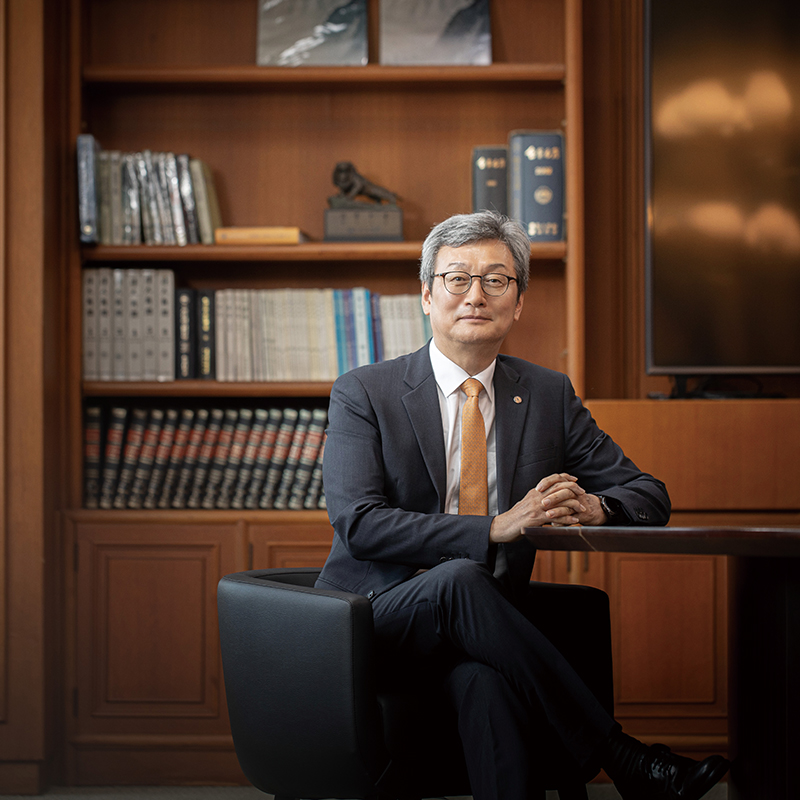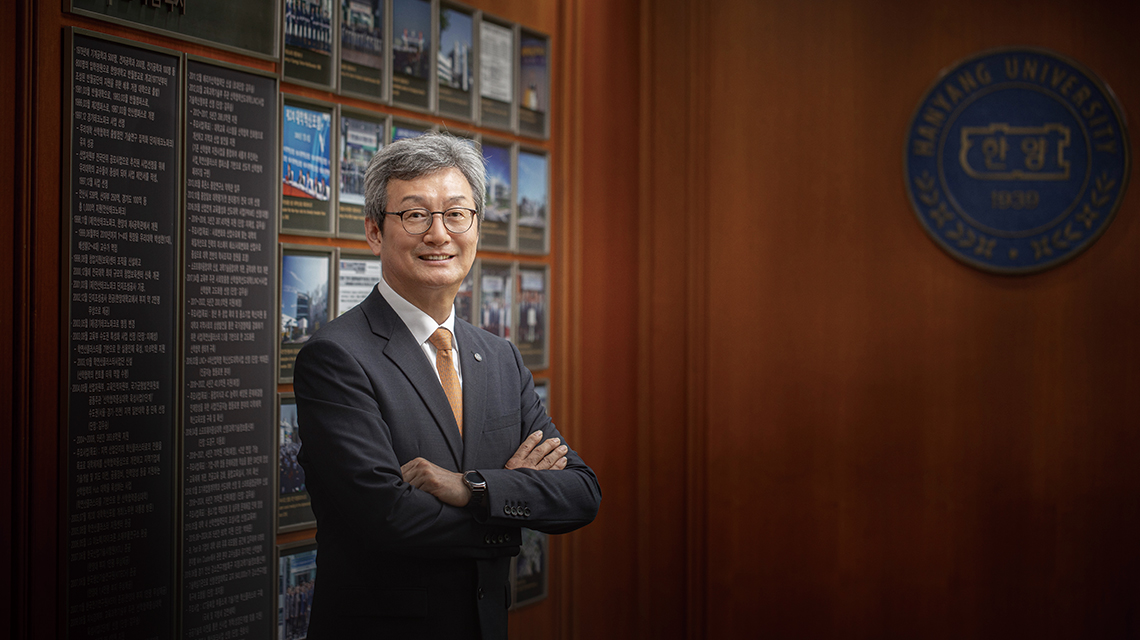Special Interview Ⅱ
Opening a New Path for
Industry-Academia Cooperation
Prof. Ki-hyung Lee, the New Executive Vice President
of Industry-University Cooperation at the Hanyang
University ERICA Campus
Professor Ki-hyung Lee of the Department of Mechanical Engineering was recently appointed as the first executive vice president for Industry-University Cooperation. Under his new leadership and based on his direct experience of industry-academia cooperation accumulated over the years, there are high expectations. We met with Prof. Lee to discuss his rising in the ranks in the leadership that has been contributing to the growth of ERICA’s industry-academia cooperation.
- Written by · Yeon-joo Lee
- Photo by · Cho-won Son

Q. We would first like to congratulate you on your appointment as the new executive vice president of Industry-University Cooperation.
Thank you. I have already been feeling that I have a very big responsibility on my shoulders as the president of the Industry-University Cooperation Foundation, where I have been researching and teaching since returning from my position as the dean of the College of Engineering three years ago. As the position of executive vice president of Industry-University Cooperation was newly established, I feel another tremendous responsibility as “the first” to hold this position. However, being “the first” also gives me a great sense of pride. I am very excited and honored to have been selected for this position. “The first” step I plan to make is with determination to pioneer a path that no one has taken before. I believe this is the last opportunity that I can have to serve ERICA as a professor, and therefore, I will do my best to meet expectations.
Q. As mentioned, the executive vice president of Industry-University Cooperation is a new position. What are the reasons for the creation of this position?
I believe the reason why I was appointed to this important position is due to my extensive experience, particularly as I am the last in my generation at the university who started from the beginning of ERICA’s industry-academia cooperation and was involved in various major national projects.
ERICA has made remarkable progress and has become a mecca of industry-academia cooperation with external expectations and demands constantly increasing. However, it is also true that ERICA urgently needs to discover a new and unique industry-academia cooperation model to maintain its dominance in this field. Also, information-sharing and a mutual cooperation systems among departments related to industry-academia cooperation have been insufficient. As a result, the position of executive vice president of Industry-University Cooperation was created precisely to solve these problems. By setting up a kind of ”control tower” that oversees the departments related to industry-academia cooperation, upgrading efforts in cooperation can be achieved, sending the message that we are making improvements our top priority. I believe my role is to achieve tangible outcomes using the education, research, and industry cluster environment, and to raise the status of the university by focusing even more on industry-university cooperation.
Q. You have been contributing to the field of industry-academia cooperation for a long time as the head of Academy-Research-Industry Cluster Support Center, the head of Industry-University Cooperation Foundation, and so forth, Please tell us about some of your most memorable achievements.
One memorable achievement has been the establishment of the Industry-University Cooperation Foundation. When I was first appointed as the deputy head of the Industry-University Cooperation Foundation, it was only located on the Seoul Campus. Thus, my office staff and I always had to go to Seoul for all approvals. To resolve this kind of inconvenience and inefficiency, I helped create an Industry-University Cooperation office on ERICA Campus. Thanks to this separation from the Seoul Industry-University Cooperation Foun-dation, we were able to start the LINC and BK21 projects as well as win government projects at the same time. I feel great pride in having laid the first foundation for success of ERICA’s industry-academic cooperation efforts.
In addition, while I served as the head of the Academy-Research-Industry Cluster Support Center, I installed equipment that was needed. As a result, we are still gaining high profits from the high usage of this equipment that is incomparable to the support centers of other universities. By operating the equipment of the Support Center, we have provided equipment to 239 companies a year. For example, the engine developed using the support center’s dynamometer was equipped in the Tivoli model of Ssangyong Motor Company (now KG Mobility), contributing to an increase in their sales. Moreover, feedback from nearby companies has been favorable.
Q. Industry-academia cooperation has always been the driving force behind ERICA’s growth. Apart from what has already been achieved, please tell us about what needs improvement.
ERICA has a wide range of unique majors including Culture Contents, Advertisement and Public Relations, Design, and Applied Music. We plan to expand the scope of industry-academic cooperation to the field of Hallyu culture development. In particular, when the Sinansan Line opens, accessibility to Yeouido will improve, helping us to strengthen industry-academia cooperation with the media industry. We will also actively support research areas involving the environment and climate change to address issues of harmful substances discharged from Banwol-Sihwa Industrial Complex. We will also hold ESG-related seminars through HY-IEE to publicize ERICA’s ESG activities to take the lead in environmental preservation and conservation.
In addition, it is necessary to provide supplemental assistance to the specialized future high-tech industry working with industry-academia cooperation. Thus, I plan to promote industry-academia cooperation by making full use of the networks that I have built by serving as the president of the Korean Society of Automotive Engineers. I intend to focus on core technologies in the automobile field using the experience I have gained over the last 20 years. Areas of focus will include autonomous driving, secondary batteries, automobile semiconductors and software, AI robots, drone, and hydrogen energy. Lastly, as the defense industry’s exports have been increasing due in particular to the Russia invasion of Ukraine, I plan to promote active defense technology research at ERICA, where the Department of Defense Information Engineering is established, and I aim to establish a contract department with defense companies.

Q. Please tell us about the technology you need to use to advance industry-academia cooperation.
As you well know, future industry technologies require a convergence of various fields. To successfully achieve convergence and conduct joint research, we are creating a database to more easily understand the major fields of the professors on campus. We are also planning a strategy to create an environment for special research by forming a research team for future core industries. In addition, we plan to boost research and development competitiveness by providing cutting-edge equipment and research space for young professors. The strategy for industry-academia advancement was something that I had always been thinking about while I worked at the Industry-University Cooperation Foundation for seven years. I have attempted various strategies while still looking for answers. However, I believe that success or failure of any policy depends on people. Knowing that there is a large difference in performance depending on the researcher who carries out the strategy, the best strategy is to focus on creating a research environment to invite outstanding professors and giving support.
Q. Recently, ERICA was selected as the regional base for the “University Creative Asset Commercialization Support Project (Bridge 3.0),” and a foundation was established to link technology to companies and region. What are the expected benefits for ERICA through this project?
By advancing the technology commercialization system through this project, commercialization results are expected such as the expansion of technology transfer with great economic value and the opening of labs for professors, thus increasing the university’s profitability. Sharing and cooperation with regional industries will also contribute to revitalization of the local economy. We plan to use these efforts to create values as a technology base university of local industries which I believe will help us gain selection for the “Regional Innovation System and Education (RISE)” project scheduled for 2025. The ongoing LINC project and the Bridge 3.0 project that we were newly selected for are both going to be converted to the RISE system, which will help highlight our role as a regionally based university that can secure advantages over other universities.

I will create an atmosphere
for every division on campus to
mutually cooperate,
and do my best
to help companies and the university
to build strong relations.

Q. Do you have any message for the members of Hanyang through this interview?
I think some members of Hanyang may think that the words industry-academia cooperation refers to something serious whereby the focus is on quantitative indicators. This is not necessarily the case. As I carry out my work, I will emphasize the word “cooperation” and I plan to create an atmosphere for every division on campus to mutually cooperate. I will do my best to help companies and the university build strong relations. By the way, the Hanyang History Museum is located next to my office. Looking at the history and photos of ERICA on the walls of the museum makes me feel that the world has changed significantly. Keeping in mind the phrase “Dreams come true” written near the school’s lake park, I promise to do my best to realize the future dream that I have envisaged over the 30 years I have been working here to benefit everyone involved.





